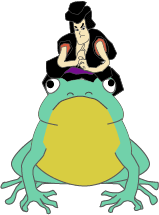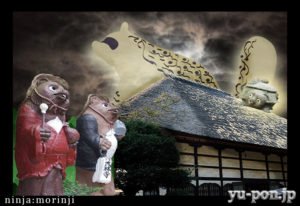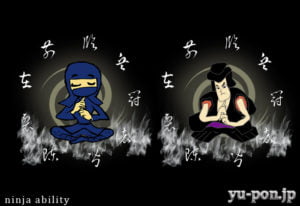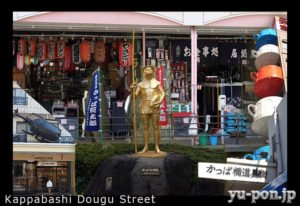Ninja’s ability
- Running ability
- Jumping power
- Qigong control, Breath control, Sprit cultivation
- Accent idiom, Dialect
- Lip reading, Mind reading
- Disguise
- Memory
- Martial arts, Hand-to-hand combat
- Special skill ;Bamboo flute, Sutra chanting, Puppet

Running ability
Horses were the fastest means of transport in the age when ninja were active and highly regarded. Assuming horses can run fast on smooth roads but it is said human being can run much faster than horses on bumpy roads.
Normally ninja’s main mission was to collect opponent’s information for feudal lord they serve and bring them back but not fighting. Ninja’s priority is in handing secret information firstly to his master who hired them. Running ability only was needed for escaping. As long as ninja were not within the shooting range of opponents sword and spear, ninja could be safe if ninja’s running ability is higher than opponent’s. Even in the case of the opponent having bow and arrow or firearm ninja will still be safe as long as they can move quickly enough in the speed the opponent cannot aim at.
At the time when the fastest means of communication had been the signal fire, human’s running power only was an important way in a short distance communication.

Speaking of ninja’s running ability it is said ninja could have run estimated 160km-200km in average per day. The record of express messenger in Edo Age shows he ran 200km a day. For that record we might say that 160km-200km could be a reasonable numbers. And also ninja ran at the speed of 15-16km per an hour. These numbers come from running on so called ninja road which run across the mountainside using beaten pass made by animal’s footsteps.
Ninja used two kinds of waraji (straw sandals), one of which is in half size named Ashihan and the other is in normal size. The Ashihan is made to have no sole under the arch of the foot in order to protect pebbles coming in. So the ninja with Ashihan waraji can run easily.
For that reason, running style called “Namba run” which is to run uniquely by using connection between the lower half and upper half of the body. And it is also a contrary method to modern way of running. You can check this Namba run on YouTube. There is a report of such that a small and weak basketball team from high school actually had made a way to participate in the National Championship of Japan by introducing Namba run in their training. If we were to estimate maximum speed, Usain Bolt run at 45km per an hour and professional soccer player run at 38km per an hour. Ninja might be able to run 40km per an hour at the top speed on a normal road.
We assume ninja must have trained themselves in running as an important ability every day since the childhood. As long as ninja had running ability, that ninja would have at least given a job working as conveyor. Speaking of running training there is a record that ninja ran with a shade on their chest in a way not dropping it or tied a kimono’s sash belt on hip but not touching it on the ground.
Jumping power
The jumping power is a prominent difference between ninja’s ability and ordinal people’s. There was a famous story that ninja sow hemp seeds in the soil first and then start training by jumping over the germ. The hemp grew up speedily and as the hemp grew higher, ninja had to keep jumping higher. So after that ninja could get a jumping ability.

Mr. Yumio Nawa (1912-2006) who was a martial artist and era historical researcher estimates that ninja’s high jump average must be 2m70cm. This height is much higher than World record of high jump at 2m 45cm. It could be guessed that the main purpose of ninja’s high jump was to utilize it for crossing over the fence so that ninja could jump to grab the top of the fence, and then chin up the body above the fence.
Karasawa Genba, famous Sanada ninja, is said to have jumped 1.8m high without running and jumped off from 12m high with no sound at landing. Suppose he was 160cm tall he could have grabbed the top of a fence easily. Yu-pon think the movement of Parkour that was developed in France look alike ninja’s movement. I recommend that you would take a look at that scene in the YouTube.
Ki, -Qigong control, Breath control, Sprit cultivation-
According to Mankawashukai which is the most famous guide-book for ninja art of Iga,ninja’s work can be divided into Yonin and In-nin. Yonin means to act positively like showing up ninja-self to his opponent. In-nin means to act negatively like hiding ninja-self on his activities. At the in-nin’s work, catching the wind of someone may lead to fatal destiny. There were many samurai with an excellent swords skills using qigong control. If ninja in in-nin’s work could not manage his breath control, sprit cultivation and qigong, he would have been caught or killed by samurai. So Mankawashukai is telling that samurai is very dangerous, ninja should run away when they happen to meet samurai.
Also there is a story of great-grandfather of Uncle Nick, he was a samurai serving to the Domain of Maeda and he taught kendo (Japanese swordsmanship) when Meiji Age began. He told his child (uncle nick’s grandfather) he could hear the sound which came from a needle fell to the ground from 8km away if he is on his concentration.
Also, Morihei Ueshiba who was the founder of Aiki-do encountered horse mounted bandits in Manchuria; he dodged from the bullet by looking at it which was shot by the bandits. Another story in the same kind is that Vietcong ducked and dodged from the bullet out of Colt Government shot by US soldiers. In ancient Japanese martial arts one had to respond to attack from behind, perform a combat skill in the dark and fight against multiple opponents, implying that qigong control, breath control and sprit cultivation were very important.
Ninja in principle had to act qigong or sprit cultivation on these situations.
The explanation of modern science tell us the relation of Ki being connected to a weak electric field (space where electric power workable) which surrounds the human body. This is called quasi electric field which was produced from inside of electrical field called bioelectric potential. Body of any creature including human being’s works as antenna surrounded by this electric field and the states of this quasi electric field changes with the body motion of the human being. As you walk the states of electromagnetic field varies that is caused by the change of shapes occurred in footsteps around the contact area or an exchange of electric charge against the ground.
A human being is said to be capable of sensing the changes in electric fields (which are called Kehai or a Ki) with inner ears or body hair. It is crucial that a swordsman has to perform a proactive attack by feeling Ki with the opponent’s eyes and a muscular astringent while his Ki is kept not tempting opponent’s attack. It could be said that ninja and samurai were required to have an ability to distinguish such environmental change using Ki information and judging the situation through ears and eyes.
In-nin’s work to sneak in opponent castle and samurai residence require ninja being not making sounds and killing his Ki. Among In-nin’s unique way of walking to name a few, run with reeling gait called fox walk, dog’s road, hare steps on grass board. Fox walk means stealthily walk. A dog’s road means a walking under the eaves, on the trees or stones wherever common places for quick hiding. When ninja go on a corridor they used the hare steps in a way placing hands first like legs and follow them by legs placed on their hands like a similar form of a rabbit’s walking. Ninja could walk on wooden corridor silently by stepping their foot onto their hands and it is much effective to walk along the side of the corridor.

When an opponent comes nearby, ninja show no sign of being there with the art of Kannon hide or quail hide. Kannon hide is an art that Ninja in standing position praying Kuji-kiri of Ingei (a sign made with the fingers) in mind; keep the distance from the battle, get right close to the fence and garden trees then bring up the sleeves so that it covers the entire face but not eyes, keeping even breathing sound silent and facing opposite of the opponent’s direction. Quail hide means a style of Iga Ninja art that would turn themselves into stone by praying Kuji-kiri of Ingei in mind with neck being pulled back and also drawing hands and legs in lie down position and facing down.
Ninja often pray Kuji-kiri of Ingei because this movement requires initiation of the mental concentration.
It’s a routine action taken by ninja for showing no sign of ninja being around in the air. It was very important for Innin Ninja to act as an air-like existence to the enemy by freezing any sign of ninja being there.
A vocabulary of a country dialect and occupational special techniques
Ninja had to speak in the country dialect where they infiltrated in a way not to get suspicious attention by locals. And ninja acquired the techniques necessary to disguise themselves to other professions such as Komuso (mendicant Zen priest of the Fuke sect) street performer, peddler of medicines, mountain priest, sarugaku (a form of theatre popular in Japan during the 11th to 14th centuries) and walking shrine maiden. Ninja picked those professions because they would not need to speak in local dialect.
Lip reading and mind reading
Lip reading was very effective way to collect enemy’s information in one’s eyesight. Also lip reading was used as communication tool in the same group in case of talking to someone nearby. And Mankawashukai (legendary record of locals) explains the other important art for Ninjutsu which was the technique of observing people by way of divination obtained from people’s facial features and atmosphere told from the appearance of the opponent’s.
The art of disguise
Nobody knew the real face of Iga Jonin ninja such as Momochi Sandayu or Fujibayasi Nagato. Because they disguised themselves as different faces so as people would not be able to identify their real face. There was a group of ninja who had special disguise skill and worked as a intermediate or a disguising trainer.
Memorial power
Ninja sneaked into the enemy territories to get the information about locations,route map, facial features of key persons, sketched map of castle and other directed items. Though broad range of information being obtained by Ninja they in fact memorized the most part and carried them back home with minimum record.
Combat techniques
Ninja who were not Ninshi (samurai ninja) were graded as 18 th out of 20 ranks available in the ranking ladder of the military groups. So, ninja never learnt samurai’s swordsmanship. Ninja used the original gear they developed which were sickle, sickle and chain connected and sword stick cane and blowgun for ninja’s eccentric attack. The primary purpose of the ninja art was basically getting enemy’s information, thus attacks using those gear was the skill for escaping as well.



